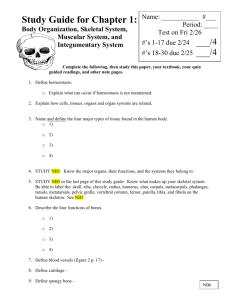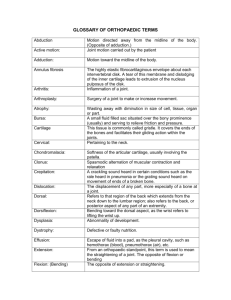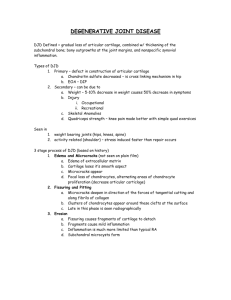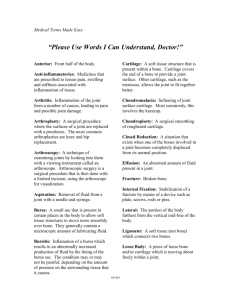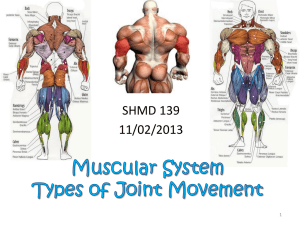Power Point Template for Poster () - Simbios
advertisement
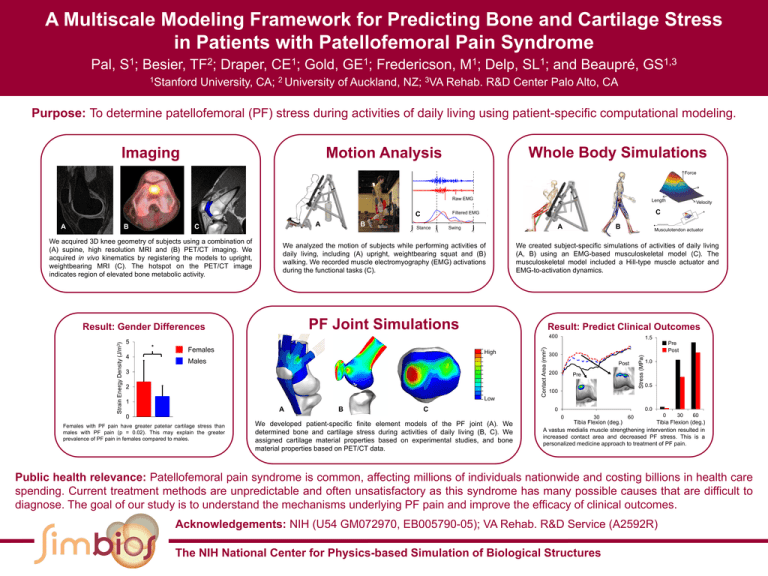
A Multiscale Modeling Framework for Predicting Bone and Cartilage Stress in Patients with Patellofemoral Pain Syndrome Pal, 1 S; Besier, 2 TF ; 1Stanford Draper, 1 CE ; University, CA; Gold, 2 University 1 GE ; Fredericson, of Auckland, NZ; 3VA 1 M; Delp, 1 SL ; and Beaupré, 1,3 GS Rehab. R&D Center Palo Alto, CA Purpose: To determine patellofemoral (PF) stress during activities of daily living using patient-specific computational modeling. Imaging Whole Body Simulations Motion Analysis Force Raw VL Raw VM Raw EMG Filtered EMG C A B A C We acquired 3D knee geometry of subjects using a combination of (A) supine, high resolution MRI and (B) PET/CT imaging. We acquired in vivo kinematics by registering the models to upright, weightbearing MRI (C). The hotspot on the PET/CT image indicates region of elevated bone metabolic activity. B Stance Length Filtered VL C Filtered VM A Swing We analyzed the motion of subjects while performing activities of daily living, including (A) upright, weightbearing squat and (B) walking. We recorded muscle electromyography (EMG) activations during the functional tasks (C). B Musculotendon actuator We created subject-specific simulations of activities of daily living (A, B) using an EMG-based musculoskeletal model (C). The musculoskeletal model included a Hill-type muscle actuator and EMG-to-activation dynamics. PF Joint Simulations Result: Gender Differences Result: Predict Clinical Outcomes Females High Males 3 2 Low 1 A B C 0 1.5 Pre Post 300 Post 200 Pre Symptomatic 100 Females with PF pain have greater patellar cartilage stress than males with PF pain (p = 0.02). This may explain the greater prevalence of PF pain in females compared to males. 1.0 0.5 VM+15% VM+30% 0.0 0 0 We developed patient-specific finite element models of the PF joint (A). We determined bone and cartilage stress during activities of daily living (B, C). We assigned cartilage material properties based on experimental studies, and bone material properties based on PET/CT data. Stress (MPa) 4 * 2 ) 2) (mm Area Contact (mm Area Contact Strain Energy Density (J/m3) 400 5 Velocity 30 60 Tibia Flexion Tibia Flexion(deg.) (deg.) 0 30 60 Tibia Flexion (deg.) A vastus medialis muscle strengthening intervention resulted in increased contact area and decreased PF stress. This is a personalized medicine approach to treatment of PF pain. Public health relevance: Patellofemoral pain syndrome is common, affecting millions of individuals nationwide and costing billions in health care spending. Current treatment methods are unpredictable and often unsatisfactory as this syndrome has many possible causes that are difficult to diagnose. The goal of our study is to understand the mechanisms underlying PF pain and improve the efficacy of clinical outcomes. Acknowledgements: NIH (U54 GM072970, EB005790-05); VA Rehab. R&D Service (A2592R) The NIH National Center for Physics-based Simulation of Biological Structures

